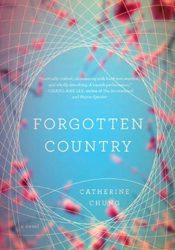
In Catherine Chung’s Forgotten Country, Janie, the eldest daughter of a Korean immigrant family and a graduate student in mathematics, has always carried the responsibility of appeasing and protecting her little sister Hannah, and has always felt she had to be “the one who had to fill the missing pieces.” On the very day of her sister’s birth, their grandmother tells young Janie that every generation of their family has lost a daughter and that it is her responsibility to keep her little sister safe. When her sister disappears just a few weeks before their father is diagnosed with cancer, Janie is called upon to set aside her studies to find her sister and convince her to return to the family before it is too late.
Janie, the eldest sister, the daughter who strives to please her parents, tries to always behave by a set of given rules of “gratitude, filial duty, and decency.” She is most lost when she must face that which does not conform to a formula or to a set of governing rules of behavior: everything human, like her little sister Hannah and her father’s cancer.
Against the odds of her father surviving his cancer, the family returns to Korea so he can undergo an experimental treatment that—were it to work—would be nothing shy of a miracle: “Miracles, Wikipedia said, were interruptions of the laws of nature that could only be explained by divine intervention.” Janie remains behind in America to find Hannah, tell her of their father’s illness, and bring her to Korea to join the rest of their family.
For Chung, folklore, family stories, and mathematical theorems are all vessels hand-picked for the emotional load they might bear. Like her protagonist, Chung herself is a former student of mathematics, and draws upon the language of mathematics to construct the powerful metaphors that occur throughout the novel: the theory of a knot incapable of unraveling, the theory of a fourth dimension where no two lines intersect one another, of an onion cut in so many little pieces it becomes larger than the sun.
Chung intersects the language of mathematics with the language of literature and storytelling in a unique and lyrical representation of the themes and theorems of human experience. Because the plot of the novel takes several turns that feel forced, the threads of these themes begin to feel like lines in a fourth dimension that fail to intersect one another. Janie wonders how her mother “could sustain such anxiety, how one body could hold it all. Then I realized it was a question of density.” This density is a quality all Chung’s characters share, and the same might be said of Chung’s novel as a whole. Every turn in the plot unveils another buried layer of suffering each family member has endured, alone in silence, resulting in a novel so incredibly dense with personal and political crises that it risks sensationalizing the portrayals of the characters’ experiences. Had some of the more minor plot points been left out, the narrative arc of Forgotten Countrywould have been just as clearly defined and as compelling for readers to follow, and without sacrificing any of the density or depth of character.
The language of literature, unlike the language of mathematics, is wonderfully imperfect; human, wavering, often times arbitrary, and always vulnerable. In her resilient debut novel, Chung refuses to spare her characters or her readers these vulnerabilities.




